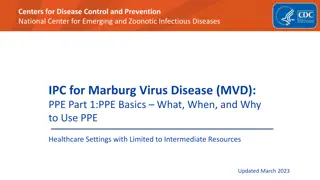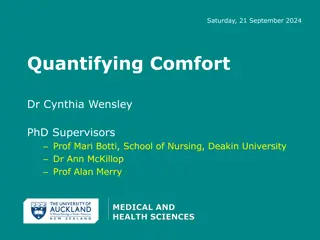An Essential Concept in Healthcare
Pain, as defined by the International Association for the Study of Pain, is a complex sensory and emotional experience associated with tissue damage. Perception of pain is influenced by various factors, making it more than just a sensation. It serves as a vital self-defense mechanism and involves neural processes. Pain threshold and tolerance play crucial roles in how individuals experience and cope with pain.
Download Presentation

Please find below an Image/Link to download the presentation.
The content on the website is provided AS IS for your information and personal use only. It may not be sold, licensed, or shared on other websites without obtaining consent from the author.If you encounter any issues during the download, it is possible that the publisher has removed the file from their server.
You are allowed to download the files provided on this website for personal or commercial use, subject to the condition that they are used lawfully. All files are the property of their respective owners.
The content on the website is provided AS IS for your information and personal use only. It may not be sold, licensed, or shared on other websites without obtaining consent from the author.
E N D
Presentation Transcript
PAIN Aakanksha Bajpai Assistant Professor School of Health Sciences
The term and concept of Pain has been defined by the International Association for the Study of Pain as an unpleasant sensory and emotional experience associated with actual or potential tissue damage or described in terms of such damage. Perception of pain is influenced by a variety of factors such as cultural differences, motivation, emotional states, and past experiences with pain.
Rather than just being a sensation, pain is a process that involves sensory, motor, and emotional responses. Pain is formally defined as: an unpleasant sensory and emotional experience associated with actual or potential tissue damage, or described in terms of such damage. Each individual learns the application of the word through experience related to injury in early life. It is unquestionably a sensation in a part of the body but is also always an emotional experience.
Pain, referred to as the fifth vital sign, serves as the bodys line of self-defense. Loss of pain sensation leaves the body, or a body area, unprotected against serious damage and, potentially, unaware that trauma has occurred. Pain is the unpleasant sensation. Nociception (from the Latin word nocere, to harm ) is the neural processes of encoding and processing noxious stimuli. The important difference is that pain must be interpreted by higher brain centers as pain and nociception is the neurophysiological processes that may be interpreted as pain.
Pain threshold is the level (intensity) of noxious stimulus required to alert the individual to a potential threat to tissue. The pain threshold can be measured experimentally by introducing a painful stimulus such as cold water, pressure, or heat and gradually increasing the intensity until the individual reports pain. Pain tolerance, on the other hand, is a measure of how much pain a person can or will withstand.67 In an experimental model, pain tolerance is measured by the amount of pain or quantity of exposure (cold water, pressure, heat) that an individual can or will endure before physically withdrawing from the painful stimuli.
Therefore, a person who reports feeling excessive pain immediately after an injury may be able to endure the pain and continue to participate because of a high level of pain tolerance. An individual having a low pain tolerance may declare that an otherwise minor injury is preventing normal activity. Pain receptors (nociceptors) activateA-delta and C fibers.
Nociceptors must be stimulated to initiate pain. There are four primary mechanisms that can trigger peripheral nociceptors: Mechanical Thermal Chemical, and Polymodal stimulation
The pain provoked by stimulation of the A-delta fibres is distinct, sharp, well localized and usually short-lasting while the pain carried by the C fibres is dull, aching, diffuse and generally long-lasting. In clinical practice it is usually the C fibre pain that brings the patient toseek aid. Nociceptors are the terminals of two types of primary afferent neurons: C fibers andA-delta fibers.
The A-delta receptors respond to strong mechanical stimulation and cause a prickling or tingling sensation when stimulated (fast pain). These impulses are carried by myelinated fibers. Slow pain is transmitted by non-myelinated C fibers and give rise to dull aching pain when stimulated.
Influences on Pain Perception To understand the patient s pain and the response to pain, factors that influence the processing and interpretation of pain information are as follows: Past Experiences The perception of pain from an injury can be influenced by a person s past experience with that injury and the consequences or the association it has with a location such as a hospital that increases anxiety. Expectations A person s expectations can influence the perception and response to pain. These expectations can come from athletic participation and influence an individual s response to pain.
Personality Extroverts express pain more freely than introverts, but introverts are more sensitive to pain. Age As with most body systems, there is degeneration in neuronal circuitry that occurs with aging that lowers pain threshold. Gender There are well-documented differences between men and women in their pain thresholds. Men typically have higher tolerance and thresholds. These can be attributed to biological, psychological, or social influences.
Terms related to pain Dyesthesia It is a general term used to denote the experience of an abnormal noxious sensation. Hyperaesthesia It is an unpleasant dyesthesia characterised by exaggerated pain response to a noxious or non-noxious stimulus. The response may occur may after repeated stimuli and may have, an exclusive quality. Allodynia It refers to the phenomenon in which a non-noxious stimuli perceive as painful.
Hyperalgesia It is defined as an increased pain response to a noxious stimulus. Hypoalgesia/Hypalgesia It denotes relatively diminished sensitivity to a noxious stimulus.























